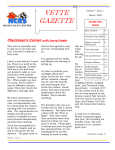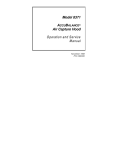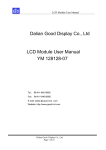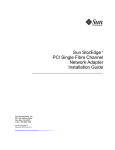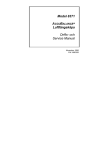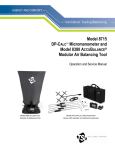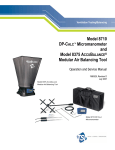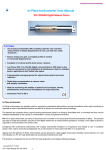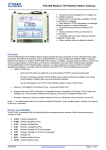Download Model 8370 AccuBalance Manual
Transcript
Model 8370 ACCUBALANCE® Flow Measuring Hood Operation and Service Manual September 1998 P/N 1980145 Rev B Model 8370 ACCUBALANCE® Flow Measuring Hood Operation and Service Manual September 1998 P/N 1980145 Rev B SHIP TO: TSI Incorporated 500 Cardigan Road Shoreview, MN 55126 U.S. Sales &Customer Service: (800)777-8356/(651)490-2711 Fax: (651)490-2874 MAIL TO: TSI Incorporated P.O. Box 64394 St. Paul, MN 55164 INTERNATIONAL Sales &Customer Service: +1-651-490-2711 Fax: +1-651-490-2874 © Copyright TSI Incorporated/Decmber 1996/All rights reserved. Address TSI Incorporated/500 Cardigan Road P.O. Box 64394 St. Paul, MN 55164/USA Fax No. (651) 490-2874 Limitation of Warranty and Liability Seller warrants that this product, under normal use and service as described in the operator's manual, shall be free from defects in workmanship and material for a period of twenty-four (24) months, or the length of time specified in operator's manual, from the date of shipment to the customer. This limited warranty is subject to the following exclusions: 1. Batteries, hot wire or hot film sensors and certain other components when indicated in specifications are warranted for a period of 90 days from the date of shipment to the customer. 2. With respect to any repair services rendered, seller warrants that the parts repaired or replaced will be free from defects in workmanship and material, under normal use, for a period of 90 days from the date of shipment to the customer. 3. Seller does not provide any warranty on finished goods manufactured by others. Only the original manufacturer's warranty applies. 4. Unless specifically authorized in a separate writing by seller, seller makes no warranty with respect to, and shall have no liability in connection with, any goods which are incorporated into other products or equipment by the Buyer. All goods returned under warranty shall be at the Buyer’s risk of loss, Seller’s factory prepaid, and will be returned at the Seller’s risk of loss, Buyer’s factory prepaid. THE FOREGOING IS IN LIEU OF ALL OTHER WARRANTIES AND IS SUBJECT TO THE CONDITIONS AND LIMITATIONS STATED HEREIN. NO OTHER EXPRESS OR IMPLIED WARRANTY OF FITNESS FOR PARTICULAR PURPOSE OR MERCHANTABILITY IS MADE. THE EXCLUSIVE REMEDY OF THE USER OR PURCHASER, AND THE LIMIT OF THE LIABILITY OF SELLER FOR ANY AND ALL LOSSES, INJURIES, OR DAMAGES IN CONNECTION WITH THIS PRODUCT (INCLUDING CLAIMS BASED ON CONTRACT, NEGLIGENCE, STRICT LIABILITY, OTHER TORT, OR OTHERWISE) SHALL BE THE RETURN OF THE PRODUCT TO THE FACTORY OR DESIGNATED LOCATION AND THE REFUND OF THE PURCHASE PRICE, OR, AT THE OPTION OF SELLER, THE REPAIR OR REPLACEMENT OF THE PRODUCT. IN NO EVENT SHALL SELLER BE LIABLE FOR ANY SPECIAL INCIDENTAL OR CONSEQUENTIAL DAMAGES. SELLER SHALL NOT BE RESPONSIBLE FOR INSTALLATION, DISMANTLING, REASSEMBLY OR REINSTALLATION COSTS OR CHARGES. NO ACTION, REGARDLESS OF FORM, MAY BE BROUGHT AGAINST THE SELLER MORE THAN ONE YEAR AFTER THE CAUSE OF ACTION HAS ACCRUED. The purchaser and all users are deemed to have accepted the terms of this LIMITATION OF WARRANTY AND LIABILITY, which contains the complete and exclusive limited warranty of seller. This LIMITATION OF WARRANTY AND LIABILITY may not be amended or modified nor may any of its terms be waived except by a writing signed by an authorized representative of seller. Service Policy Knowing that inoperative or defective instruments are as detrimental to TSI as they are to our customers, our service policy is designed to give prompt attention to any problems. If any malfunction is discovered, please contact your nearest sales office or representative, or call TSI's Customer Service department at (651) 490-2711 or (800) 777-8356. Contents About this manual 1 Introduction 3 Chapters 1 Setup Unpacking Parts Identification Keypad Display Preparing the Instrument for Use Display Units Installing the Batteries Start Up Continuous Reading Mode Averaging Mode Selecting Flow Direction Taking a Flow Measurement Turning the ACCUBALANCE Off Automatic Shut-off 5 5 7 9 10 11 14 14 15 15 15 16 16 17 17 2 Operations in More Detail Changing Hoods Switching On the Power Selecting Flow Direction Continuous Reading Mode Averaging Mode Selecting Flow Units Selecting the Time Constant Changing DIP Switch Settings Low Battery Warning Automatic Shut-off Connecting the Optional Printer 19 19 26 26 27 27 28 28 29 32 32 33 i RS-232 Serial Output 33 3 Maintenance Fabric Hood Meter Manifold Calibration 35 35 36 36 37 4 Troubleshooting 39 Appendices A B C D E Standard Flow vs. Actual Flow Back Pressure ACCUBALANCE Serial Interface Connections Return Mode Low Flow Corrections Specifications 41 43 45 47 49 Tables 1 1a 1b 2 3 4 5 List of Components List of Components Model 8370-3 List of Components Model 8370-5 DIP Switch Settings Printout Examples Hood Fabric Part Numbers Troubleshooting the ACCUBALANCE 5 6 6 32 33 35 39 Illustrations 1 2 3 4 5 6 7 ii The ACCUBALANCE and Accessories ACCUBALANCE Components Electronic Meter Membrane Switch Electronic Meter Display An Easy Way to Begin Assembly Installing a Support Pole Assembled 2 ft x 4 ft Frame 7 8 9 10 12 13 20 8 9 10 11 12 13 14 15 16 17 18 Installing a Support Pole Assembled 1 ft x 4 ft Frame Assembled 1 ft x 5 ft Frame Assembled 3 ft x 3 ft Frame ACCUBALANCE Lying Face Down Location of DIP Switches Flow Sensing Tube Out of Place Pressure Drop Through the ACCUBALANCE 9-Pin, RS-232 Serial Interface Connections 25-Pin, RS-232 Serial Interface Connections 25-Pin to 9-Pin, RS-232 Serial Interface Connections 22 23 24 25 30 31 37 44 45 46 46 iii iv About this manual This manual explains how to set up, operate and maintain the Model 8370 ACCUBALANCE Flow Measuring Hood. Read it thoroughly before using the instrument. Formatting and Typography Note that step-by-step instructions are numbered in boldface type: 1, 2, 3, etc., set flush-left against the margin. References to the front panel keys on the ACCUBALANCE, along with the instrument's displayed readout, are represented in this manual by the typeface called Helvetica Narrow. In addition to the different typeface, displayed messages appear in quotes. When reference is made to other sections of the manual, the section title is italicized. Example: The "HOLD" message will appear along with a flow value after you have activated the HOLD button (from Display in Chapter 1). HELP! If you need technical assistance with this instrument, have questions about the manual, or your flow hood needs repair or recalibration please call TSI's Insustrial Test Instruments Group at (651) 490-2711 or ✟ (800) 777-8356. 1 2 About this manual Introduction The TSI Model 8370 ACCUBALANCE is an instrument designed to measure the air flow from diffusers and grilles or the air flow entering exhaust outlets. The ACCUBALANCE is lightweight and easy to use. The instrument can display the measured air flow in three different units: standard cubic feet per minute (SCFM), standard liters per second (Std l/s) and standard cubic meters per hour (Std m3/hr). The ACCUBALANCE consists of a fabric hood, a molded plastic base which contains an electronic meter, and a flow sensing manifold located within the base. Air flowing through the hood is measured by a hot-film sensor located in the central hub of the flow sensing manifold. The twenty-four pairs of flow sensing ports in the manifold are strategically located so that the ACCUBALANCE provides the highest degree of measurement accuracy, even in non-uniform flow conditions. The ACCUBALANCE is temperature-compensated to display a standard flow rate: SCFM, Std. l/s and Std. m3/hr. Standard flow rate is defined as the volumetric flow rate at standard conditions of 70°F (21.1°C) and 14.7 pounds per square inch (760 mmHg) barometric pressure. Standard flow rate is the measurement used most often in ✟ ventilation applications. 3 4 Introduction Chapter 1 Set Up This chapter guides you through unpacking, setting up, and getting started using your ACCUBALANCE. See Chapter 2 for a detailed description of all operating features. Unpacking Carefully unpack the instrument and accessories from the carrying case. Check the individual parts against the list of components in Table 1. If any are missing or damaged, notify TSI immediately. Table 1. List of components Qty Item 1 Model 8370 base 1 2 ft x 2 ft (610 mm x 610 mm) hood fabric 6 Frame support poles 4 2 ft (610 mm) frame tubing* 6 Right angle tubing connectors* 1 Battery holder 4 C-size batteries 1 Battery compartment cover 1 Carrying case 1 Operation and Service Manual Part No. 1081388 1307060 1081390 1081262 1081584 1081279 1208018 1081458 1319067 1980145 *Four 2 ft frame tubings and four of the right angle connectors are shipped assembled inside the top of the hood fabric. 5 Table 1a. List of components: Model 8370-3 Qty Item 1 Model 8370 base 1 2 ft x 2 ft (610 mm x 610 mm) hood fabric 1 2 ft x 4 ft (610 mm x 1220 mm)hood fabric 1 1 ft x 4 ft (305 mm x 1220 mm)hood fabric 6 Frame support poles 6 2 ft (610 mm) frame tubing* 4 1 ft (305 mm) frame tubing 6 Right angle tubing connectors* 6 Straight tubing connectors 1 Battery holder 4 C-size batteries 1 Battery compartment cover 1 Carrying case 1 Operation and Service Manual Part No. 1081388 1307060 1801065 1801066 1081390 1081262 1081260 1081584 1302833 1081279 1208018 1081458 1319067 1980145 Table 1b. List of components: Model 8370-5 Qty Item 1 Model 8370 base 1 2 ft x 2 ft (610 mm x 610 mm) hood fabric 1 2 ft x 4 ft (610 mm x 1220 mm) hood fabric 1 1 ft x 4 ft (305 mm x 1220 mm) hood fabric 1 1 ft x 5 ft (305 mm x 1525 mm) hood fabric 1 3 ft x 3 ft (915 mm x 915 mm) hood fabric 6 Frame support poles 6 2 ft (610 mm) frame tubing* 4 1 ft (305 mm) frame tubing 6 Right angle tubing connectors* 6 Straight tubing connectors 1 Battery holder 2 1x tube connectors 4 C-size batteries 1 Battery compartment cover 1 Carrying case 1 Operation and Service Manual Part No. 1081388 1307060 1801065 1801066 1801067 1801068 1081390 1081262 1081260 1081584 1302833 1081279 1081580 1208018 1081458 1319067 1980145 *Four of the 2 ft frame tubings and four of the right angle connectors are shipped assembled inside the top of the hood fabric. 6 Chapter 1 Figure 1. The ACCUBALANCE and accessories Included with every manual is a registration card. Look for yours at the front of this manual. Please complete and mail it promptly; it allows TSI to inform you of product updates. Parts Identification Before proceeding with assembly and use of the ACCUBALANCE, please familiarize yourself with the various parts of the instrument. As you read the next sections, refer to figures 2 - 4. Set Up 7 Figure 2. ACCUBALANCE components 1. Hood fabric 2. Base 3. PRINT button in left handle 4. START/HOLD button in right handle 8 Chapter 1 Keypad Figure 3. Electronic meter membrane switch ON/OFF Press to turn the ACCUBALANCE on and off. PRINT Press to transmit the displayed flow rate measurement to the printer or other serial device. Note that the button in the left handle performs the same function. DATA PORT Printer (or other serial device) connection port. (Remove Data Port Plug before connecting serial device.) Set Up 9 START/HOLD In the Averaging Mode, press to start a new reading. In the Continuous Reading Mode, press and release to hold the value on display. Press again to resume continuous readings. Note that the button in the right handle performs the same function. AVG/CONT Press to switch between the Averaging and the Continuous Reading Modes. RETURN/SUPPLY Press to switch between return air and supply air measurements. Display Figure 4. Electronic meter display Figure 4 shows the electronic meter display. All segments will be shown momentarily each time you turn on the ACCUBALANCE. 10 Chapter 1 1. Flow units: CFM (cubic feet per minute), l/s (liters per second), and m3/hr (cubic meters per hour). The ACCUBALANCE indicates flow already corrected to "standard" conditions (see Appendix A). 2. Flow value: See specifications for range and resolution. 3. Flow direction arrow: Indicates if supply or return air flow calibration is being utilized by the ACCUBALANCE. Notice: Be sure this arrow points in the direction of flow through the ACCUBALANCE, otherwise the measurements made will be inaccurate. To change the direction of the arrow, press the RETURN/SUPPLY switch. 4. Averaging mode: The "AVERAGE" message will appear on the display when you have selected the three-second or six-second averaging mode (See Averaging Mode section later in this chapter). 5. Hold indicator. The "HOLD" message will appear along with a flow value after you have activated the HOLD button. 6. "LOW BATTERY". Displayed when batteries are getting near the end of their useful life. 7. "BATTERY" will appear along with a value on the display during power-up to indicate the percent of battery life remaining. Preparing the Instrument for Use Hood Assembly The ACCUBALANCE is shipped from the factory partially assembled with the 2 ft x 2 ft nylon hood attached to the base. If you wish to use another hood size, see Changing Hoods in Chapter 2. Set Up 11 To complete the assembly of the 2 ft x 2 ft hood, follow these six steps: 1 Place the base of the ACCUBALANCE on the floor. 2 Lift the top of the fabric. Insert one end of a support pole into its pole mount in the base of the ACCUBALANCE. There is a cup in each corner of the frame to accept the other end of each support pole. Helpful Hint: This step is made simpler by temporarily resting the opposite corner of the fabric top on a table edge as shown in Figure 5. Figure 5. An easy way to begin assembly 12 Chapter 1 3 Grasp the support pole. Bend the pole slightly to insert the top end of the pole into the support pole cup located in the corner of the fabric frame as shown in Figure 6. Figure 6. Installing a support pole 4 Insert the second support pole into the pole mount on the opposite side of the ACCUBALANCE base. 5 Repeat step 3 for the second support pole. 6 Repeat steps 4 and 5 for the remaining two support poles. Set Up 13 Display Units The ACCUBALANCE is shipped with cubic feet per minute (CFM) as the default flow unit (unless the metric version was ordered). If you wish to change the units to l/s (liters per second) or m3/hr (cubic meters per hour), see Changing Dip Switch Settings in Chapter 2 Installing the Batteries The ACCUBALANCE requires four C-size batteries to operate. For your convenience, four alkaline batteries are included with the ACCUBALANCE. To install the batteries, follow these three steps: 1 Remove the battery cover located behind the electronic meter on the inner side of the ACCUBALANCE base. To remove the battery cover, pull up on the latches located on the top and bottom of the cover. 2 Place batteries in the battery holder located inside the battery compartment. Follow the illustration on the battery holder for correct battery orientation. 3 Replace the battery cover. Notice that the battery cover is designed to fit only one way, with the tab pointing toward the fabric. Engage the latches by pressing down on them. WARNING: Never leave batteries in the ACCUBALANCE for more than two weeks. Leaking batteries can cause electronic failure due to corrosion. Notice: Remove batteries from the battery compartment during shipping, travel and transport. Jostling may jar the batteries loose and cause damage to the ACCUBALANCE . 14 Chapter 1 Start-Up Press the ON/OFF button on the meter to turn on the power. The display will initially indicate the percent of battery power remaining. During start-up the ACCUBALANCE performs a self test of its electronic functions. If an error is found, an error message will appear on the display. Refer to Chapter 4, Troubleshooting, if an error message appears. If no errors are found, the ACCUBALANCE will automatically proceed to one of two measurement modes: continuous reading mode or averaging mode. Continuous Reading Mode In the continuous reading mode, the measurement is updated on the display every second. You can slow the update rate to once every two seconds by changing the setting of DIP Switch 7. For more details, see Changing DIP Switch Settings in Chapter 2. The display continues to update until you press either the START/HOLD switch on the keypad or the button on the right handle. The current value will be held on the display along with the "HOLD" message. To resume continuous readings, press one of the START/HOLD buttons again. For more details about the continuous reading mode, see Chapter 2. Averaging Mode In the averaging mode, a time-averaged reading is initiated each time you press the START/HOLD switch on the keypad or the button on the right handle. The time counts down from three seconds on the display. After the countdown, the average flow appears and remains on the display along with the "AVERAGE" message. To initiate a new reading, press one of the START/HOLD buttons again. You can select an Set Up 15 averaging time of six seconds by changing the setting of DIP Switch 6. See Changing DIP Switch Settings in Chapter 2. For more details on the averaging mode, see Chapter 2. Selecting Flow Direction Each ACCUBALANCE is calibrated for supply and return air separately for increased accuracy. The ACCUBALANCE will assume that air is flowing in the same direction as the arrow on the right-hand side of the display. Be sure this arrow points in the direction of flow through the ACCUBALANCE, otherwise measurements will be inaccurate. To change the direction of the arrow, press the RETURN/SUPPLY switch. Taking a Flow Measurement You are now ready to start measuring flow rates. First, turn on the ACCUBALANCE and select the appropriate flow direction. For measuring supply air flow, the arrow must point down away from the hood fabric; for return air flow measurements, the arrow must point up toward the hood fabric. Next, choose the Continuous Reading Mode and be sure that the "HOLD" message is not on the display. If the "HOLD" message is on the display, press either the START/HOLD switch on the keypad or the button on the right handle to resume readings. Finally, press the top of the ACCUBALANCE against the perimeter edge of the diffuser or grille so as to form a seal. The electronic meter will display standard flow readings. If the readings are fluctuating, choose the averaging mode by pressing the AVG/CONT switch on the keypad. In the Averaging Mode, it is important to keep the ACCUBALANCE in place over the diffuser or grille during the countdown and until the average reading appears on the 16 Chapter 1 display. A new average reading can be initiated by pressing the START/HOLD switch or the button on the right handle. When making a flow measurement, keep objects out of the flow path at the base of the ACCUBALANCE (one foot clearance minimum). However, it is acceptable to have a hand supporting the flow hood at the bottom of the base. Turning the ACCUBALANCE Off To turn off the ACCUBALANCE, simply press the ON/OFF switch. Automatic Shut-off The ACCUBALANCE will automatically shut itself off if no switches or buttons have been pressed for 15 minutes. This feature minimizes accidental loss of battery power. Set Up ✟ 17 18 Chapter 1 Chapter 2 Operations in More Detail This chapter explains how to change fabrics and assemble different hood sizes and presents more detail on the various features of the ACCUBALANCE. Changing Hoods The ACCUBALANCE is shipped with a 2 ft x 2 ft hood attached to the base. Four other hood sizes are available from TSI and can be purchased separately or as part of standard packages. Available hood sizes are identified by the dimensions of the frame structure at the top of the hood and include 2 ft x 4 ft, 1 ft x 4 ft, 1 ft x 5 ft and 3 ft x 3 ft . To change hood sizes, first remove the hood currently attached to the base. To remove the attached hood, first unlatch the cinch belt where the fabric is attached to the base. Then remove the fabric from its frame structure by peeling back the Velcro® from the aluminum frame tubing. Notice that the fabric stretches around the outside, then up and over the frame structure. The Velcro on the fabric reaches down to mate with the Velcro on the frame structure. Notice also that all Velcro surfaces on the frame tubing face inward. Finally, fold up the fabric you just removed so that it can fit into one of the accessory pockets inside the ACCUBALANCE carrying case. It is a good idea to fold the fabric so that the tag identifying its size remains visible for future reference. 19 2 ft x 4 ft Hood To assemble and attach the 2 ft x 4 ft hood, carefully follow these 10 steps: 1 Build the 2 ft x 4 ft frame structure as shown in Figure 7 using six 2 ft aluminum frame tubing pieces, four right-angle tubing connectors, and two straight tubing connectors. Remember to construct the frame so that all Velcro surfaces face in (toward the center of the structure). Notice: Make sure that all support pole cups in the aluminum frame tubing pieces are facing downward. Figure 7. Assembled 2 ft x 4 ft frame 2 Unfold the 2 ft x 4 ft hood fabric. 3 Insert the frame into the fabric and fasten the fabric to the frame using the Velcro surfaces. The fabric stretches around the outside, then up and over the frame structure. The Velcro on the fabric reaches down to mate with the Velcro on the inner surface of the frame structure. When completed, the soft rubber gasket material should lie in a straight line along the top surface of all four sides of the frame. 20 Chapter 2 Notice: Be sure to press the Velcro surfaces firmly together. When completed, the hood fabric will be stretched fairly taut and will require good bonding of the fabric to the frame. 4 Stretch the cinch belt at the bottom of the fabric over the lip around the top of the molded plastic base of the ACCUBALANCE. Align the seams of the fabric panels with the pairs of screw heads that hold the four pole mounts to the ACCUBALANCE base. Align so that the cinch belt latch is on the side of the base opposite the electronics meter. 5 Pull the strap at the latch very tight to attach the fabric to the base. Make sure that the strap stays tucked under the protruding lip all around the top of the base. Pay particular attention to where the strap passes the handles. 6 Now it is time to install the support poles. You will find four white marks on the inside top edge of the fabric. These marks identify the location of cups on the underside of the frame tubing that will accept the ends of the support poles. At this time it is helpful to be near a table or some other thighhigh surface to help hold up the fabric while you install the first support pole (refer to Figure 5 on page 12). 7 With the base of the ACCUBALANCE on the floor, lift the fabric frame up so that a white mark is directly in front of you. Support the opposite side of the frame structure on a nearby table or other level surface as shown in Figure 5. Take one support pole and insert one end into its pole mount in the ACCUBALANCE base. Bend the pole slightly to guide the other end into the corresponding support pole cup located on the underside of the frame near the white mark on the fabric. Operations in More Detail 21 Figure 8. Installing a support pole 8 Repeat step 7 until all four support poles are installed. 9 Now that the hood is assembled and the fabric is stretched tight, it is a good practice to check the rubber gasket around the top edge of the ACCUBALANCE fabric. In order to achieve a good straight alignment of the rubber gasket along the top of the frame structure, you may need to peel back and re-attach small portions of the Velcro surfaces. 10 Finally, at the corners, tuck the straight rubber gasket flaps under the edges cut at an angle. This will create a virtually leak-free, soft, pliant seal. 22 Chapter 2 1 ft x 4 ft Hood To assemble and attach the 1 ft x 4 ft hood, carefully follow these 10 steps: 1 Build the 1 ft x 4 ft frame structure as shown in Figure 9 using four 2 ft aluminum frame tubing pieces, two 1 ft aluminum frame tubing pieces, four right-angle tubing connectors, and two straight tubing connectors. Remember to construct the frame so that all Velcro surfaces face in (toward the center of the structure). Notice: Make sure that all support pole cups in the aluminum frame tubing pieces are facing downward. Figure 9. Assembled 1 ft x 4 ft frame 2 Unfold the 1 ft x 4 ft fabric hood. Continue with steps 3 through 10, beginning on page 20. 1 ft x 5 ft Hood To assemble and attach the 1 ft x 5 ft hood, carefully follow these 10 steps: Operations in More Detail 23 1 Build the 1 ft x 5 ft frame structure as shown in Figure 10 using four 2 ft aluminum frame tubing pieces, two 1x tube connectors, two 1 ft aluminum frame tubing pieces, and four right-angle tubing connectors. Remember to construct the frame so that all Velcro surfaces face in (toward the center of the structure). Notice: Make sure that all support pole cups in the aluminum frame tubing pieces are facing downward. Figure 10. Assembled 1 ft x 5 ft frame 2 Unfold the 1 ft x 5 ft fabric hood. Continue with steps 3 through 10, beginning on page 20. 24 Chapter 2 3 ft x 3 ft Hood To assemble and attach the 3 ft x 3 ft hood, carefully follow these 10 steps: 1 Build the 3 ft x 3 ft frame structure as shown in Figure 11 using four 2 ft aluminum frame tubing pieces, four 1 ft aluminum frame tubing pieces, four right-angle tubing connectors, and four straight tubing connectors. Remember to construct the frame so that all Velcro surfaces face in (toward the center of the structure). Notice: Make sure that all support pole cups in the aluminum frame tubing pieces are facing downward. Figure 11. Assembled 3 ft x 3 ft frame 2 Unfold the 3 ft x 3 ft fabric hood. Continue with steps 3 through 10, beginning on page 20. Operations in More Detail 25 Switching On the Power The power ON/OFF switch is located on the meter keypad of the ACCUBALANCE. To turn the power on, momentarily press the ON/OFF switch. The ACCUBALANCE will immediately light all display digits and sound the buzzer. After a second, the approximate percent of remaining battery life will be displayed. If fresh, new alkaline batteries are used, the value will be near 100-percent. Other batteries, such as NiCd batteries, may show a lower value even when they are fully charged. Notice: The percent power remaining will not be accurate for NiCd batteries because they do not discharge linearly with power use. While the battery life is being displayed, the ACCUBALANCE will automatically perform a series of self tests. If an error is detected, the display will show an error number. Refer to Troubleshooting in Chapter 4 for interpretation of the error message. If no errors are detected during start-up, the ACCUBALANCE will proceed to one of its two operating modes: continuous reading mode or averaging mode. As long as the batteries have not been removed or the DIP switch settings have not been changed, the ACCUBALANCE will return to the mode it was in when it was last used. Selecting Flow Direction The ACCUBALANCE is designed to accurately measure air flow in either direction through the hood. For highest performance accuracy, every ACCUBALANCE is calibrated with flow in each direction separately. Therefore, it is very important that you select the flow direction using the RETURN/SUPPLY switch on the keypad before you make a measurement. The arrow in the upper right hand area of the display will change direction each time you press the RETURN/SUPPLY switch 26 Chapter 2 on the keypad. Make sure the arrow is pointing in the direction of the flow before you make a measurement. Continuous Reading Mode In this mode the display is continuously updated either once every second or every other second. The ACCUBALANCE is shipped with a one-second display update rate. The update rate can be changed to once every two seconds by changing DIP switch 7 in the battery compartment (see Changing DIP Switch Settings later in this chapter). Changing the update rate to two seconds can help reduce fluctuations in the readings (using the averaging mode will also help stabilize the readings). The flow rate can be held on the display by pressing the START/HOLD switch on the keypad or the button in the right handle. This is a valuable feature if you do not have the optional printer. The hold function will allow you to set the instrument down to manually record a measurement. Of course, the printer would make the job even easier. With the printer, all you would have to do is press the PRINT button instead of setting the instrument down and writing the value by hand. To resume continuous readings when a value is being held on the display, simply press the START/HOLD switch or the button in the right handle. Averaging Mode This mode can be identified by the "AVERAGE" message appearing on the display. You can toggle between continuous reading mode and averaging mode by repeatedly pressing the AVG/CONT switch on the keypad. Operations in More Detail 27 In the averaging mode, the ACCUBALANCE takes flow measurements for three or six seconds and then displays and holds the time-averaged flow. The averaging time can be changed between three and six seconds by changing DIP switch 6 inside the battery compartment (see Changing DIP Switch Settings later in this chapter). The display will count down while the ACCUBALANCE is taking flow measurements. Notice: You must keep the ACCUBALANCE in place during the entire countdown and until the time-averaged measurement appears on the display. Selecting Flow Units The ACCUBALANCE is capable of displaying measured flow rates in three different measurement units: CFM (Cubic Feet per Minute), l/s (Liters per Second), and m3/hr (Meters cubed per Hour). DIP switches 3 and 4 control the display units. Refer to Changing DIP Switch Settings later in this chapter to change the flow units. Selecting the Time Constant The ACCUBALANCE allows you to choose between two measurement speeds in both the continuous reading mode and in the averaging mode. In the continuous reading mode you may select either a onesecond or a two-second display update rate. The ACCUBALANCE is shipped from the factory set up to operate at the one-second display rate. You may change to a two-second display rate by adjusting switch 7 under the battery cover (see Changing DIP Switch Settings). The flow sensor in the ACCUBALANCE is extremely fast and actually samples flow at a rate of 10 times per second. Thus, the values displayed in the one-second mode represent an integration of 10 readings each. Likewise, the values displayed in the 2-second mode represent an integration of 20 readings each. By selecting the slower 28 Chapter 2 (2-second) display rate, you will therefore see less variation in the displayed values. In the averaging mode, you may choose between a three-second and a six-second averaging time period. The ACCUBALANCE is shipped set up in the three-second averaging mode. You can change this by changing the setting of switch 6 in the battery compartment (see Changing DIP Switch Settings). Changing DIP Switch Settings You can change flow units and time constants by adjusting the settings of the DIP switches located inside the battery compartment. To gain access to the DIP switches, first turn off the ACCUBALANCE and lay down the instrument with the electronic meter facing down as shown in Figure 12. Operations in More Detail 29 Figure 12. ACCUBALANCE lying face down Remove the battery compartment cover by pulling up on the two latches. You will see the switches numbered 1 through 8 in the corner of the battery compartment. You may wish to remove or tilt up the battery pack to allow easier access to the switches as shown in Figure 13. 30 Chapter 2 Figure 13. Location of DIP Switches You may change the switch settings using the tip of a ball-point pen, pencil, compass, small screwdriver, or other small, pointed object. Refer to Table 2 for switch settings. Operations in More Detail 31 Table 2. DIP Switch Settings Switch Number Setting: Function 1 Leave in OFF position 2 Leave in OFF position 3,4 3 OFF, 4 OFF: Flow units = CFM 3 OFF, 4 ON: Flow units = l/s 3 ON, 4 ON: Flow units = m3/hr 5 Leave in OFF position for Rev A thru Rev M Leave in ON position for Rev N and later 6 OFF: 3-second averaging in Averaging Mode ON: 6-second averaging in Averaging Mode 7 OFF: 1-second display update rate in Continuous Reading Mode ON: 2-second display update rate in Continuous Reading Mode * See the serial number sticker on the unit to find the Rev level of your ACCUBALANCE unit. Low Battery Warning When a battery power is running low, the message "LOW BATTERY" will appear on the display. NOTE: The readings given by the ACCUBALANCE when "LOW BATTERY" is displayed are still valid. Before the battery power gets so low that valid flow measurements are not possible, the ACCUBALANCE will shut itself off. When the "LOW BATTERY" message appears, you usually have at least a half hour of running time before the power gets so low that the ACCUBALANCE would automatically turn itself off. If the optional printer is connected, the message "LOW BATTERY" is printed just before the ACCUBALANCE turns itself off. Automatic Shut-off The ACCUBALANCE has an automatic shut-off feature to help save battery life. If no switches or buttons are pushed for fifteen minutes, the ACCUBALANCE will shut itself off. 32 Chapter 2 Connecting the Optional Printer The ACCUBALANCE can be used with an optional portable printer. The printer provides hard copy of selected flow rates and eliminates the awkward task of manually recording flow rates while operating a flow measuring hood. To connect a TSI Model 8925 Portable Printer to the ACCUBALANCE, locate the interface cable that was shipped with the printer. The cable has a modular RJ-45 (telephone type) connector on one end and a 9-pin D-connector on the other end. Simply connect the 9-pin D-connector to the printer and the RJ-45 connector to the ACCUBALANCE DATA PORT. If you find that the printer prints only question marks "?", turn the printer off and then on again. For details about how to operate the Model 8925 Portable Printer, refer to the manual that was shipped with it. RS-232 Serial Output The DATA PORT on the ACCUBALANCE is used to interface to a printer, digital data logger, or other serial device. The connector required for the RS-232 port on the ACCUBALANCE is an eight-pin, modular RJ-45 type connector. For communications specifications and details about the cable wiring configuration of the RS-232 port, refer to Appendix C, ACCUBALANCE Serial Interface Connections. The serial output from the ACCUBALANCE is transmitted in ASCII format. Table 3 lists examples of the output from the ACCUBALANCE. Table 3. Print-out Examples Continuous Reading Mode Flow = 435 CFM Flow = 1580 m3/hr Flow = 132 l/s Operations in More Detail 33 Averaging Mode 3 sec Average = 435 CFM 3 sec Average = 1580 m3/hr 6 sec Average = 132 l/s 34 ✟ Chapter 2 Chapter 3 Maintenance The ACCUBALANCE is designed for long-term field use. If the ACCUBALANCE is used with reasonable care, it should be able to make precise measurements over a long time period. Some of the components can be cleaned periodically. When cleaning the components, please follow the instructions given below. Fabric Hood The hoods can be washed with mild detergent and cold water. When washing the hood, keep the hood away from objects with sharp corners or sharp edges. Careless cleaning may cause damage. If the fabric gets ripped it should be replaced or repaired. Duct tape can be placed over the rip on both sides of the fabric for temporary repair. To replace a damaged fabric or to order a different fabric size, contact your local TSI distributor. To determine who your local TSI distributor is, you may call TSI toll-free at 1-800-876-9874. If you wish to order a new hood fabric, use the following part numbers shown in Table 4. Table 4. Hood Fabric Part Numbers Fabric Hood Size 2 ft x 2 ft (610 mm x 610 mm) 2 ft x 4 ft (610 mm x 1220 mm) 1 ft x 4 ft (305 mm x 1220 mm) 3 ft x 3 ft (915 mm x 915 mm) 1 ft x 5 ft (305 mm x 1525 mm) Part Number 800590 800591 800592 800593 800594 35 Frame Kit 1081263 It is recommended that you purchase a frame kit whenever you purchase a hood other than the 2 ft x 2 ft size. The frame kit contains all extra frame tubing and connectors required to build frames for the various size hoods. The frame kit consists of the following parts: 4 pieces 1-foot frame tubing 2 pieces 2-foot frame tubing 6 pieces straight tubing connectors Meter The ACCUBALANCE has a built-in electronic flow meter. Do not try to detach the meter from the base. The ACCUBALANCE should be used and stored within the specified temperature range, 32 - 140º F (0-60º C). The meter case, display screen and membrane switch can be cleaned using a damp cloth with mild detergent solution. Do not immerse the meter in water. Wipe the meter dry before use. Manifold If you notice that a tube in the flow sensing manifold has become disengaged from its rubber holder as shown in Figure 14, work the tube end back into the holder. The accuracy of the ACCUBALANCE is not affected by having one or two tubes out of their holders; however, it is a good practice to keep the tubes properly in place. 36 Chapter 3 Figure 14. Flow Sensing Tube Out of Place If you observe the flow sensing taps of the manifold becoming clogged with dust or other material, clean them with a damp cloth. The manifold should be kept in place during cleaning. Do not apply excessive forces on the grid tubes of the manifold. If any of the tubes are bent or damaged, please contact TSI for repair information. Calibration TSI recommends an annual calibration for the ACCUBALANCE. For a nominal fee, TSI will calibrate the unit and return it to you with a certificate of calibration and NIST traceability. This 'annual checkup' assures you of consistently accurate readings. To calibrate the ACCUBALANCE, please ship TSI the complete package that includes the meter, the base, the manifold and any fabrics used. Everything should Maintenance 37 be packed carefully within the ACCUBALANCE carrying case and then inside a proper shipping box, such as the original shipping box. Ship directly to: 38 TSI, Inc. ATTN: Customer Service 500 Cardigan Road Shoreview, MN 55126-3996 ✟ Chapter 3 Chapter 4 Troubleshooting Table 5 lists the symptoms, possible causes, and recommended solutions for common problems encountered with the ACCUBALANCE. If your symptom is not listed, or if none of the solutions solves your problem, please contact TSI. Table 5. Troubleshooting the ACCUBALANCE Symptom No display "LOW BATTERY" on display Flashing "0" (Flow is under range) Possible Causes Corrective Action Unit not switched on Press ON/OFF button. Low or dead batteries Replace the batteries. Dirty battery contacts Clean the battery contacts. Battery holder not connected Plug in battery holder. Low battery charge Replace the batteries. Dirty battery contacts Clean the battery contacts. Trying to read too low a flow Flow may not be measurable using the ACCUBALANCE. Object is blocking flow through ACCUBALANCE Remove obstruction. 39 Table 5 (continued) Symptom Possible Causes Corrective Action Sensor grid tubes are plugged Clean the tubes. ACCUBALANCE is not sealing around diffuser Reposition the ACCUBALANCE to form a seal. Flashing flow value "> 0" (Flow is over range) Trying to read too high a flow Flow may not be measurable using the ACCUBALANCE. Flow reading fluctuates badly The flow is fluctuating Use a longer time constant. "ERR2" appears The flow sensor is giving an erroneous reading Return to the factory for service. "ERR1" appears Temperature compensation sensor is damaged Return to the factory for service. Unit is or was recently in ambient temperature outside of operating temperature Allow unit to stabilize in the operating temperature range of 32 - 140ºF (0 - 60ºC). The ACCUBALANCE has detected a calibration fault Return to the factory for service. "ERR3" appears ✟ 40 Chapter 4 Appendix A Standard Flow vs. Actual Flow Standard flow is defined as the volumetric flow rate of air at "Standard" temperature and barometric pressure conditions of 70ºF (21.1ºC) and 14.7 psia (760 mmHg). By contrast, actual flow is the volumetric flow rate of air at local temperature and barometric pressure conditions. It is common in ventilation test applications that standard flow is the desired measurement parameter. The ACCUBALANCE automatically indicates standard flow readings. There is therefore no need to apply a correction factor; however, if you wish to convert standard flow readings to actual flow readings, you must apply an air-density correction factor: ⎡ 14.7 ⎤ ⎡ 460 + Tact ⎤ Actual Flow = (Standard Flow ) ⎢ ⎣ Pact ⎥⎦ ⎢⎣ 530 ⎥⎦ where Pact = Your local barom etric pressu re in psia . Tact = Your air flow temperatu re in ° F. Or ⎡ 760 ⎤ ⎡ 27315 . + Tact 1 ⎤ Actual Flow = (Standard Flow ) ⎢ 1 ⎥ ⎢ ⎣ Pact ⎦ ⎣ 294.25 ⎥⎦ Pact 1 = Your local barometric p ressure in mm H g. where Tact 1 = Your air flow tem perature in ° C. 41 Example 1: Suppose your air flow temperature is 55ºF and you local barometric pressure is 13.5 psia, and the standard flow indicated on the ACCUBALANCE is 200 (standard) CFM. ⎡ 14.7 ⎤ 460 + 55 Actual Flow = 200 ⎢ = 212 A ctual CFM ⎣ 13.5 ⎥⎦ 530 Example 2: Suppose your air flow temperature is 25ºC, and your local barometric pressure is 730 mmHg, and the standard flow indicated on the ACCUBALANCE is 100 (standard) l/s. Actual Flow = 100 42 760 ⎡ 273.15 + 25 ⎤ = 105 A ctual l s 730 ⎢⎣ 294.25 ⎥⎦ Appendix A ✟ Appendix B Back Pressure It is commonly known that a flow measuring hood may induce a back pressure. In general, back pressures are caused by restrictions in the flow path as well as frictional pressure losses. In order to improve accuracy and sensitivity, all flow measuring hoods incorporate a contracted flow section. The contracted section restricts the flow through the hood which induces a back pressure. A hood having a more abrupt contraction than the ACCUBALANCE may induce greater back pressure due to the turbulence caused by the abrupt contraction. In addition any apparatus within the hood, such as supporting poles and the flow manifold, also induces some frictional pressure drop. Back pressure may cause slight errors in the flow measurements. Figure 15 shows the pressure drop through the ACCUBALANCE over its entire flow range. As shown in the figure, the back pressure is only 0.05 in. H2O at a flow rate as high as 1000 CFM. 43 Figure 15. Pressure Drop through the ACCUBALANCE If you wish to make back pressure corrections, you must first determine the back pressure correction factor, Cb. The back pressure correction factor, Cb, can be determined as follows: Vo Cb = ---V (8-1) where V and Vo are the average air velocities in the duct ahead of the diffuser with and without the capture hood in place, respectively. With the known correction factor, the back-pressure corrected flow can be determined using Equation (8-2): Back-pressure corrected flow = Displayed flow x Cb 44 (8-2) ✟ Appendix B Appendix C ACCUBALANCE Serial Interface Connections A 9-pin cable (Model 8926) is available for use with the ACCUBALANCE and the TSI Model 8925 Portable Printer. This cable allows a direct connection between the ACCUBALANCE and the printer. Its connections are as follows: ACCUBALANCE pin 1 pin 2 pin 3 tied together pin 4 transmit data pin 5 pin 6 signal ground pin 7 tied together pin 8 no connection Signal Name tied together tied together Printer pin 1 pin 7 pin 2 pin 6 pin 3 pin 9 pin 5 pin 8 pin 4 Signal Name receive data signal ground busy Figure 16. 9-pin, RS-232 serial interface connections for Model 8925 Printer All lines shown are connected, but only the data line going to the printer and the ground are actually used in this configuration. The pins labeled "tied together" are connected together inside the ACCUBALANCE. A 25-pin cable (Model 8927) is available for connecting the ACCUBALANCE to a personal computer. This cable allows a direct connection between the ACCUBALANCE and the computer. Its connections are as follows: 45 Signal Name tied together tied together tied together transmit data ground tied together ACCUBALANCE pin 1 pin 2 pin 3 pin 4 pin 5 pin 6 pin 7 pin 8 Computer pin 8 pin 5 pin 2 pin 6 pin 3 pin 22 pin 7 pin 20 Signal Name carrier detect clear to send transmit data data set ready receive data ring indicator ground data term ready Figure 17. 25-pin, RS-232 serial interface connections for personal computer The pins labeled "tied together" are connected together inside the ACCUBALANCE. This puts the "data set ready" and "clear to send" lines at the proper logic level for your computer to receive data. If you wish to connect the ACCUBALANCE to a computer which uses a 9-pin connector for serial communications, an adapter may be used. This is a standard 25-pin to 9-pin adapter with male pins on the 25-pin side and female pins on the 9-pin side. Such an adapter is supplied with the Model 8927 Computer Interface Cable or is available from a number of computer supply houses. Its connections are as follows: 9-Pin Female Side pin 1 pin 2 pin 3 pin 4 pin 5 pin 6 pin 7 pin 8 pin 9 25-Pin Male Side pin 8 pin 3 pin 2 pin 20 pin 7 pin 6 pin 4 pin 5 pin 22 Signal Name carrier detect receive data transmit data data term ready ground data set ready request to send clear to send ring indicator Figure 18. 25-pin to 9-pin, RS-232 serial interface connections 46 ✟ Appendix C Appendix D Return Mode Low Flow Corrections The ACCUBALANCE is calibrated in a vertical position. Thus, in the Return Mode, air is flowing up through the ACCUBALANCE base and then through the fabric hood. When using the ACCUBALANCE in a horizontal orientation at flows below 100 CFM (50 l/s), such as at a side wall return vent, the ACCUBALANCE will read slightly lower than the true flow. At 80 CFM (40 l/s), for example, the ACCUBALANCE will read low by 2 CFM (1 l/s). Therefore, you may wish to add 2 CFM (1 l/s) when the indicated flow is 80 CFM (40 l/s); 3 CFM (1.5 l/s) at 50 CFM (25 l/s); and 4.5 CFM (2 l/s) at 30 CFM (15 l/s) to obtain a more accurate reading. No correction is required at flows greater than 100 CFM (50 l/s). Notice: This correction factor is necessary only in the Return Mode. The Supply Mode does not require a correction. 47 48 Appendix D Appendix E Specifications Flow Range 30-2,000 CFM (15-1,000 l/s, 50-3,500 m3/hr) Accuracy ±5% rdg, ±5 CFM (±2.4 l/s, 8.5 m3/hr) Operating Temperature Range 32-140°F (0-60°C) Weight (using 24 in × 24 in Hood) 7 lb 6 oz (3.4 kg) Hood Sizes Available 24 in × 24 in; (610 mm × 610 mm) 24 in × 48 in; (610 mm × 1220 mm) 12 in × 48 in; (305 mm × 1220 mm) 12 in × 60 in; (305 mm × 1525 mm) 36 in × 36 in; (915 mm × 915 mm) Power 4 C-size batteries (4 alkaline batteries provided) Battery Life At least 40 hours of continuous use Carrying Case 26 in × 26 in × 7 in (660 mm × 660 mm × 180 mm) RS-232C Output ASCII Character codes 1200 Baud No parity 8 data bits 1 stop bit No handshaking These specifications are subject to change without notice. ✟ 49 50 Appendix E


























































